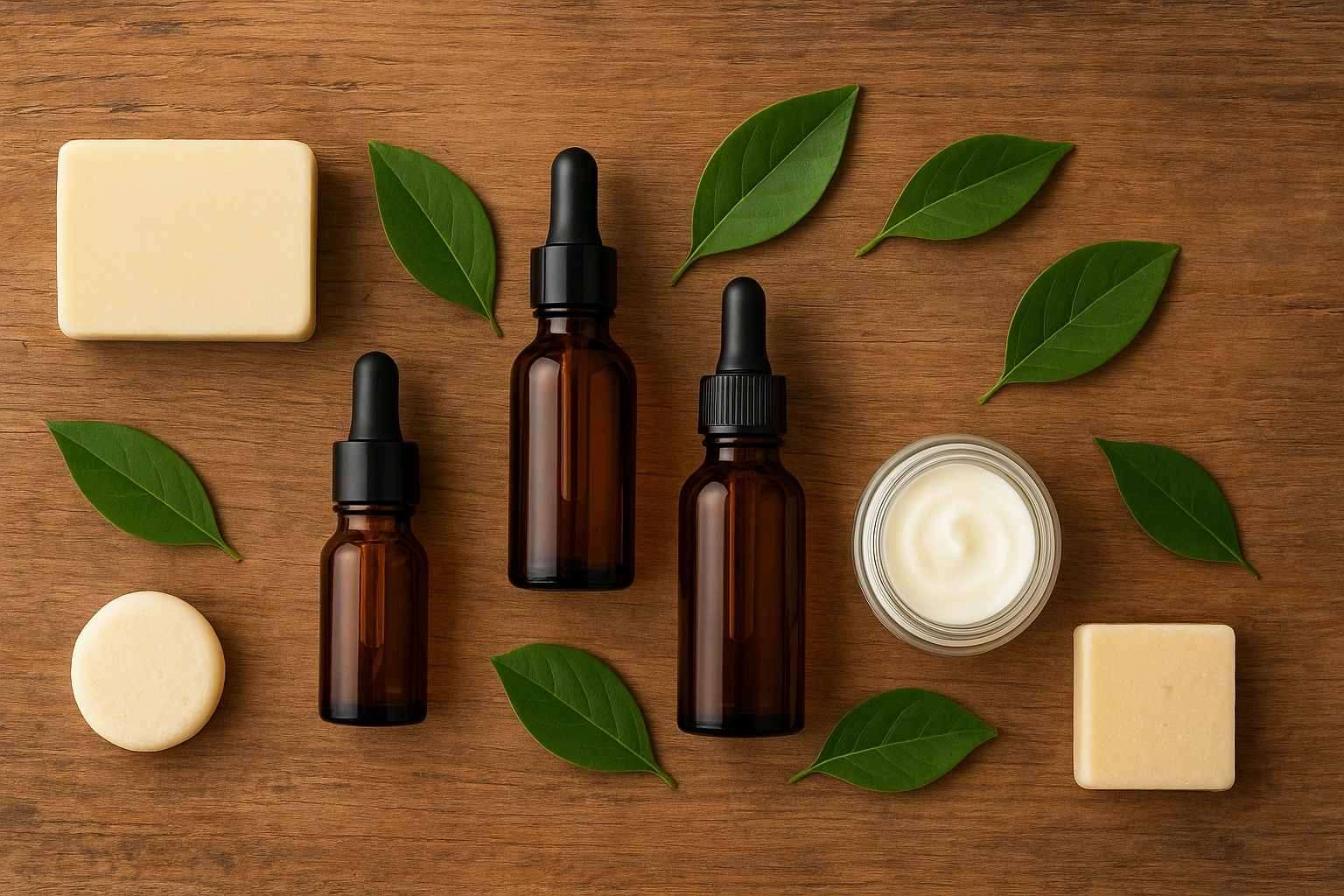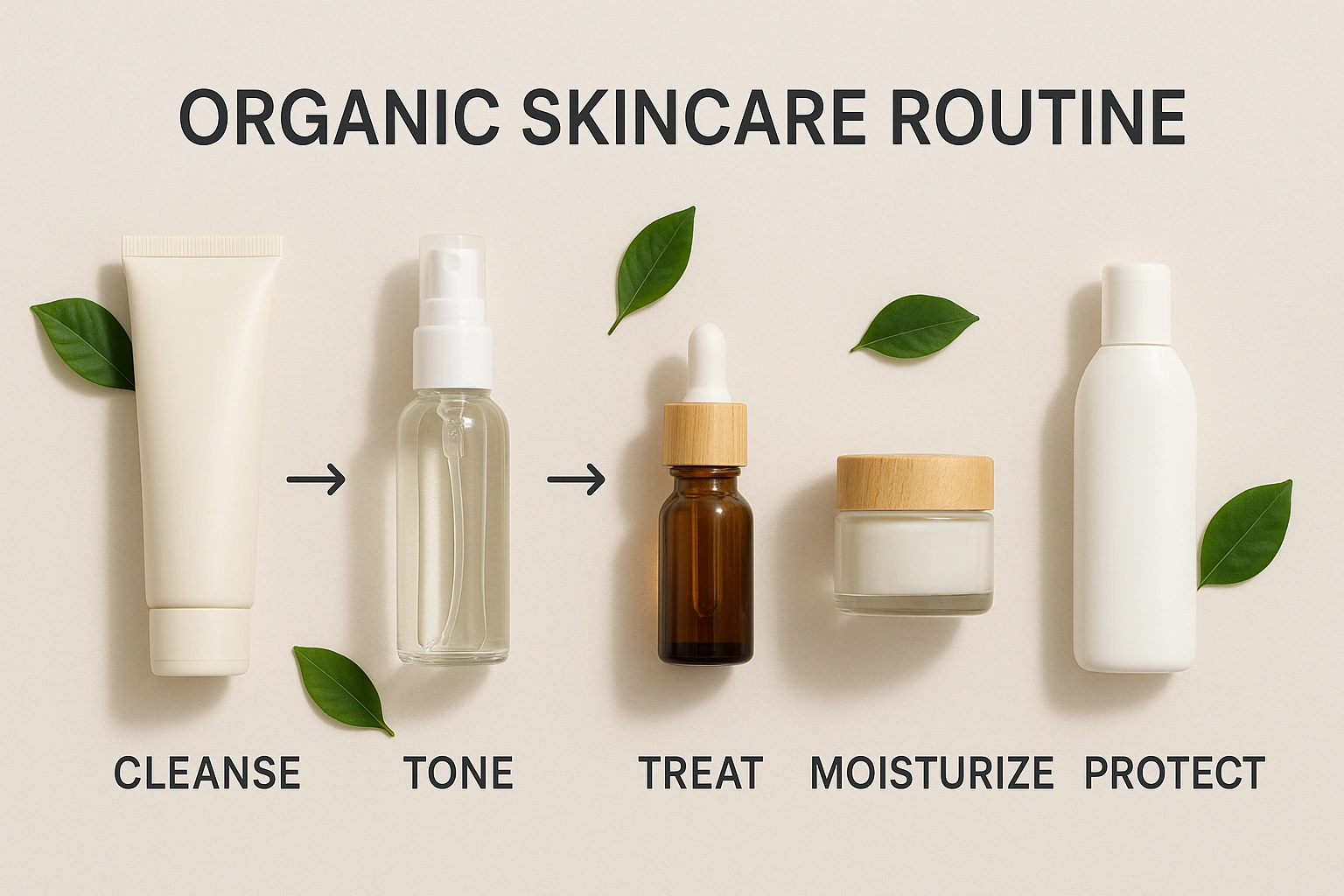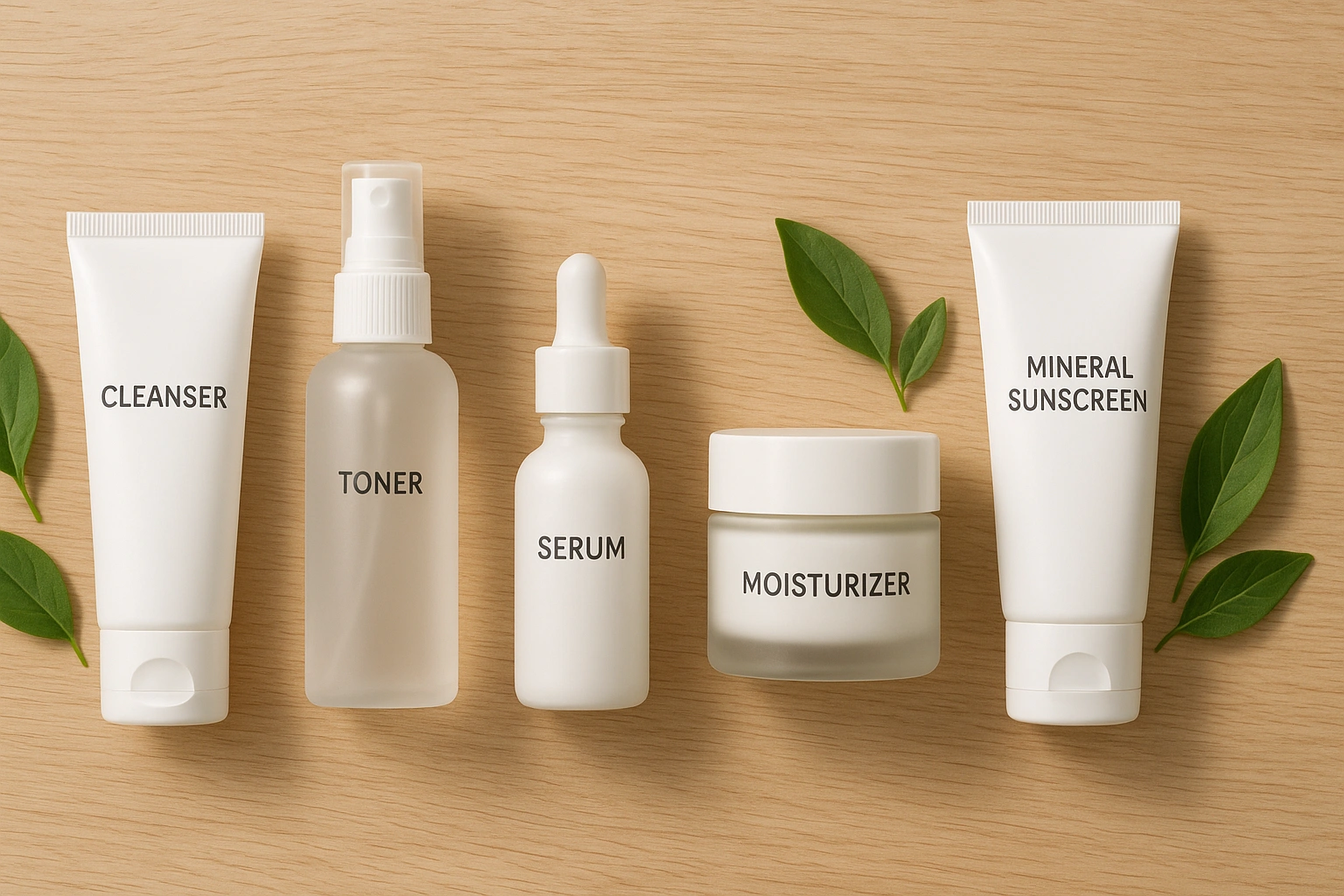Are you tired of scanning ingredient lists filled with unpronounceable chemicals? The clean beauty movement has gone mainstream, but following an organic skincare routine makes it much easier to avoid that confusion.
You want healthy, glowing skin, but you don’t want to compromise on safety or effectiveness, and that’s where an organic skincare routine offers clarity and balance.
This guide is designed to cut through the noise and show you how an organic skincare routine can be simple, effective, and tailored to your needs.
Get ready to ditch harsh synthetics and embrace the power of nature with an organic skincare routine that brings out your best skin ever.
- What is an Organic Skincare Routine?
- Why an Organic Routine Matters for Your Skin
- How to Build Your Organic Skincare Routine: The 5 Core Steps
- My Journey to an Organic Routine
- Comparison: Choosing the Right Organic Product for Your Skin Type
- Common Mistakes to Avoid When Going Organic
- Expert Tips & Best Practices
- Frequently Asked Questions (FAQ)
- Conclusion
What is an Organic Skincare Routine?
An organic skincare routine is a daily regimen that relies on products made with ingredients grown and processed without synthetic pesticides, herbicides, fertilizers, or GMOs.
At its core, an organic skincare routine is about nourishing your skin with elements kept as close to their natural state as possible.
This approach makes an organic skincare routine not only a choice for healthier skin but also a way to avoid unnecessary chemicals.
Ultimately, an organic skincare routine prioritizes personal well-being while supporting environmental sustainability.
In 2025, consumers are more educated than ever about what they put on their bodies. The demand for transparency has fueled the organic beauty market’s growth, which, according to a report from TechCrunch, is part of a larger wellness trend disrupting the traditional cosmetics industry. People are choosing certified organic products to avoid potential irritants and support eco-friendly farming practices.

Why an Organic Routine Matters for Your Skin
Switching to organic products is more than just a trend; it’s an investment in your skin’s long-term health. Here are the key benefits.
Avoids Harsh Chemicals and Irritants
Conventional skincare can be loaded with parabens, phthalates, sulfates, and artificial fragrances that can irritate the skin, disrupt hormones, and cause allergic reactions. Organic products use gentle, plant-based preservatives and natural scents, making them ideal for sensitive skin.
Provides Potent, Nutrient-Rich Ingredients
Plants grown organically have been shown to have a higher concentration of antioxidants and vitamins compared to their conventionally grown counterparts. This means your skin gets a more potent dose of the good stuff—like vitamins C and E, and polyphenols—that fight free radicals and prevent premature aging. These are the ultimate **natural beauty tips** straight from the earth.
Supports a Healthier Planet
Organic farming practices are designed to be sustainable. They protect soil health, conserve water, reduce pollution, and are safer for wildlife and farm workers. When you choose organic, you’re casting a vote for a healthier ecosystem. For more on sustainability, see these advancements in green technology.
How to Build Your Organic Skincare Routine: The 5 Core Steps
Building your routine doesn’t have to be complicated. Focus on these five essential steps for both morning and night (with a few minor tweaks).

- Step 1: Cleanse Gently: Start with a certified organic cleanser. For oily skin, try a gel cleanser with tea tree oil. For dry skin, a cream or oil cleanser with rosehip oil is perfect. This removes impurities without disrupting your skin’s natural moisture barrier.
- Step 2: Tone and Hydrate: Ditch harsh, alcohol-based toners. Instead, use a hydrating organic facial mist or essence with ingredients like rosewater, aloe vera, or hyaluronic acid (from plant sources) to balance and prep the skin.
- Step 3: Treat with a Serum: This is your problem-solving step. Choose a concentrated organic serum to target your specific concerns. Use a Vitamin C serum in the morning for antioxidant protection and a serum with bakuchiol (a natural retinol alternative) at night for anti-aging.
- Step 4: Moisturize and Nourish: Lock everything in with a high-quality organic moisturizer. Look for facial oils like jojoba or argan oil, or creams rich in shea butter and botanical extracts that match your skin type.
- Step 5: Protect (AM Only): This is the most crucial morning step. Apply a broad-spectrum mineral sunscreen with an SPF of 30 or higher. Look for non-nano zinc oxide formulas that are reef-safe and free from synthetic filters.
My Journey to an Organic Routine
I used to think my sensitive, acne-prone skin needed harsh chemicals to stay clear. I decided to try a simple, 3-step organic routine for a month: a gentle cleanser, a rosehip oil serum, and a lightweight moisturizer. I was nervous about using oil on my skin, fearing it would make things worse.
The first week, my skin was less red and felt calmer. By the end of the month, not only was my skin clearer, but it had a healthy glow that I’d never been able to achieve with my old products. It taught me that nourishing my skin, rather than stripping it, was the real key.
| Pros of an Organic Routine | Cons of an Organic Routine | |
|---|---|---|
| My Experience | Reduced inflammation and redness, skin felt balanced and hydrated, achieved a natural glow. | Products can be more expensive, natural scents take getting used to, requires patience to find the right products. |
Comparison: Choosing the Right Organic Product for Your Skin Type
| Skin Type | Best Organic Cleanser | Best Organic Moisturizer | Best For |
|---|---|---|---|
| Oily / Acne-Prone | Foaming cleanser with tea tree or salicylic acid (from willow bark). | Lightweight gel or lotion with aloe vera. | Balancing oil production and preventing breakouts. |
| Dry / Dehydrated | Cream or oil-based cleanser with avocado oil. | Rich cream with shea butter or facial oil like argan oil. | Deeply hydrating and repairing the skin barrier. |
| Sensitive | Micellar water or a very gentle milk cleanser with chamomile. | Fragrance-free cream with calendula or oat extract. | Calming inflammation and reducing redness. |
| Mature | Hydrating cream cleanser with antioxidants. | Moisturizer with bakuchiol and plant peptides. | Boosting collagen and reducing fine lines. |
Common Mistakes to Avoid When Going Organic
- Falling for “Greenwashing”:** Don’t be fooled by pretty packaging with leaves on it. Look for official certification seals like USDA or Ecocert.
- Switching Everything at Once:** Introduce one new product at a time over a few weeks. This helps you identify what works and what might be causing a reaction.
- Ignoring the Expiration Date:** Organic products use natural preservatives, so they often have a shorter shelf life. Check the date to ensure potency.
- Using Too Much Product:** Organic formulas are often highly concentrated. A little goes a long way!
- Giving Up Too Quickly:** It can take your skin a full cycle (about 28 days) to adjust to a new routine. Be patient and consistent.
Expert Tips & Best Practices
Ready to get the most out of your new routine? Here are some pro tips.
- Patch Test Everything: Before applying a new product to your face, test it on a small patch of skin (like your inner arm) for 24 hours to check for a reaction.
- Apply to Damp Skin: Apply serums and moisturizers to slightly damp skin to lock in extra hydration.
- Don’t Forget Your Neck and Chest: Extend your entire routine down to your décolletage to keep the skin there looking as youthful as your face.
- Store Products Properly: Keep your organic products, especially those with Vitamin C, in a cool, dark place to preserve their effectiveness.
“The best organic skincare routine is a consistent one. The power of these products lies in their ability to work with your skin’s natural processes over time. Don’t look for an overnight miracle; look for long-term health and balance.”
— Dr. Chloe Davis, Naturopathic Doctor
Frequently Asked Questions (FAQ)
Q: How long does it take for an organic skincare routine to work?
A: It typically takes about 28-30 days, which is one full skin cell turnover cycle, to see noticeable results. However, you might feel immediate benefits like better hydration and less irritation.
Q: Is ‘natural’ the same as ‘organic’?
A: No. ‘Natural’ is an unregulated term that can mean anything. ‘Organic’ is a regulated term. Look for official certifications like USDA Organic or Ecocert to ensure a product meets strict standards for farming and ingredient processing without synthetic pesticides or fertilizers.
Q: Can organic skincare cause breakouts?
A: Yes, any new product can potentially cause breakouts, a process sometimes called ‘purging.’ This is especially true if you have sensitive skin or are switching from synthetic products. Introduce new products one at a time to see how your skin reacts.
Q: Is an organic skincare routine more expensive?
A: It can be, but not always. Many affordable organic brands exist. Also, because organic products often use higher concentrations of effective ingredients, you may find you need to use less product, making it cost-effective in the long run.
Q: What is the most important product in an organic routine?
A: While every step is important, a high-quality, organic mineral sunscreen is arguably the most crucial. It protects your skin from sun damage, which is the number one cause of premature aging, and prevents you from undoing the benefits of your other products.
Conclusion
Building an organic skincare routine is a rewarding act of self-care that brings long-term benefits for both your skin and the environment.
By following a consistent organic skincare routine with five simple steps—cleanse, tone, treat, moisturize, and protect—you can see visible improvements over time.
Patience is key, and an organic skincare routine encourages you to listen to your skin and adapt gently rather than rushing results.
With dedication, an organic skincare routine helps you nourish your skin with nature’s best, starting a journey toward healthier and naturally glowing skin today.
For a deeper dive into ingredient safety, visit the Environmental Working Group’s Skin Deep database.
